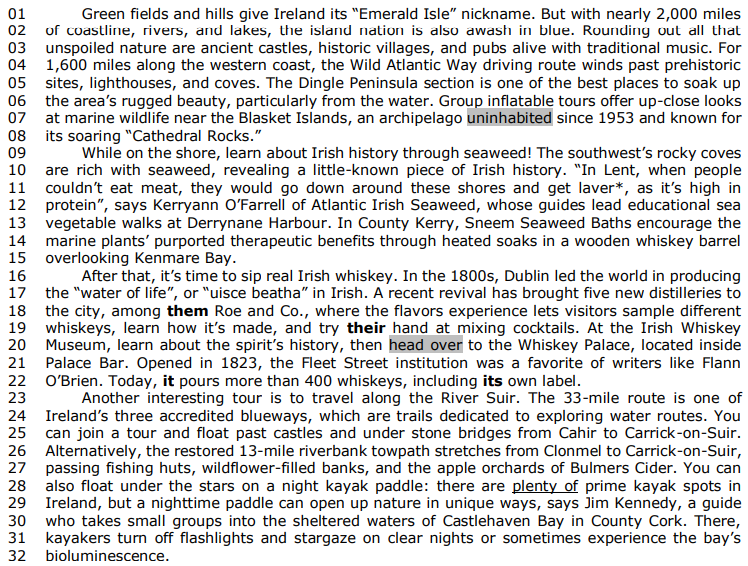Questões de Concurso
Foram encontradas 1.078 questões
Resolva questões gratuitamente!
Junte-se a mais de 4 milhões de concurseiros!
Things to do in Ireland

*laver: a type of seaweed / seaweed: alga marinha
(Available at: www.nationalgeographic.com/travel/article/10-best-things-to-do-ireland – text specially adapted
for this test).
Text 18A3-I
The roar of a waterfall suggests the power of water. Rampaging floodwaters can uproot strong trees and twist railroad tracks. When the power of water is harnessed, however, it can do useful work for humans.
Since ancient times, people have put the energy in the flow of water to work. They first made water work for them with the waterwheel, a wheel with paddles around its rim. Flowing water rotated the waterwheel, which in turn ran machinery that was linked to it. Today, new kinds of waterwheels — turbines — spin generators that produce electricity. Electricity from water-turned generators is known as hydroelectricity.
By building a dam across a river, the natural upstream water level is elevated and a difference in head is created that can be used to drive turbines and generate electricity. A large upstream reservoir may balance seasonal water flow; rain or melted snow can be stored in the reservoir during the wet season to provide electricity during dry seasons.
Waterpower is distributed unevenly among the continents and nations of the world. Europe and North America have developed much of their waterpower. Asia, South America, and Africa have abundant waterpower potential, but while countries such as China and Brazil have become leading hydroelectric producers, much of the waterpower resource on those continents remains undeveloped.
Elizabeth Lachner. Hydroelectricity. Rosen Publishing Group, 2018 (adapted).
Text 18A3-I
The roar of a waterfall suggests the power of water. Rampaging floodwaters can uproot strong trees and twist railroad tracks. When the power of water is harnessed, however, it can do useful work for humans.
Since ancient times, people have put the energy in the flow of water to work. They first made water work for them with the waterwheel, a wheel with paddles around its rim. Flowing water rotated the waterwheel, which in turn ran machinery that was linked to it. Today, new kinds of waterwheels — turbines — spin generators that produce electricity. Electricity from water-turned generators is known as hydroelectricity.
By building a dam across a river, the natural upstream water level is elevated and a difference in head is created that can be used to drive turbines and generate electricity. A large upstream reservoir may balance seasonal water flow; rain or melted snow can be stored in the reservoir during the wet season to provide electricity during dry seasons.
Waterpower is distributed unevenly among the continents and nations of the world. Europe and North America have developed much of their waterpower. Asia, South America, and Africa have abundant waterpower potential, but while countries such as China and Brazil have become leading hydroelectric producers, much of the waterpower resource on those continents remains undeveloped.
Elizabeth Lachner. Hydroelectricity. Rosen Publishing Group, 2018 (adapted).
Text 19A4-II
Photo exhibitions are great opportunities for excited and ambitious photographers to showcase their work beyond just the safety of their friends and family. They’re also a stellar opportunity to develop a thicker skin, as your work will be subject to critique, but that’s all part of the territory that comes with getting more exposure as a photographer, which is what all artists should strive for. Beyond that, they’re a great way to advertise yourself as a photographer, both your talents and your availability. Think of it almost as the artist’s equivalent to having a booth at a trade show when you’re selling a product.
First-timers to an exhibition will likely find themselves a bit unsure of what to do and somewhat nervous. Here’s a series of surefire tips to make any exhibition a success. Before you do anything else, it’s imperative that you make up your mind about what you’ll be showcasing at your exhibition. You only have two choices, when you think about it: brand-new work that you’ll shoot especially for the exhibition or archival stuff that you’ll just pull out for the exhibition. Also, being creative when finding the exhibition location is as important as the showcase itself.
Internet: <https://contrastly.com> (adapted).